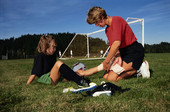- Skip Storing This Everyday Product in the Fridge Door
- Green Tea + B3 Pairing May Boost Brain Health
- Navigating Your Midlife Crisis: Embracing New Possibilities
- City Raccoons Showing Signs of Domestication
- Mapping the Exposome: Science Broadens Focus to Environmental Disease Triggers
- One Week Less on Social Media Linked to Better Mental Health
- Your Brain Changes in Stages as You Age, Study Finds
- Some Suicide Victims Show No Typical Warning Signs, Study Finds
- ByHeart Formula Faces Lawsuits After Babies Sickened With Botulism
- Switch to Vegan Diet Could Cut Your Greenhouse Gas Emissions in Half
Concussions Common in Middle School Girls Playing Soccer: Study


Girls who play soccer in middle school are vulnerable to concussions, new research shows.
And despite medical advice to the contrary, many play through their injury, increasing the risk of a second concussion, the study found.
Although awareness has increased about sports concussions, little research has been done on middle school athletes, especially girls, noted study co-author Dr. Melissa Schiff, a professor of epidemiology at the University of Washington School of Public Health in Seattle.
In the study, which evaluated 351 soccer players between the ages of 11 and 14, Schiff and her colleagues found 59 concussions. A concussion is defined as a traumatic injury to the brain after a blow, shaking or spinning. In the study, the girls’ symptoms included headache, dizziness, drowsiness and concentration problems.
That rate of injuries, Schiff said, is higher than what has been reported at either high school or college level of women’s soccer.
Heading the ball was to blame for about 30 percent of the injuries. This involves hitting the ball with your forehead to redirect the ball in play. More than half of the concussions were from contact with another player.
Experts recommend those who have a concussion be evaluated by a doctor or other health care professional trained in the injury, but Schiff found that ”56 percent were never evaluated.” Experts also advise that players not return to practice or games until symptoms disappear, but 58 percent of the players in the study continued to play even with symptoms persisting, she said.
The study was published online Jan. 20 in the journal JAMA Pediatrics.
Awareness about the dangers of concussions has increased, Schiff said, beginning with the National Football League’s attention to the problem. Research about the problem has slowly increased to encompass college-level, high school, and now middle school players, she said.
In this study, the researchers randomly selected 33 of 72 elite teams from four youth soccer clubs in the Puget Sound region of Washington state. The study continued from 2008 to 2012. Players reported injuries and symptoms.
With so many injuries blamed on heading the ball, should it be banned?
Schiff thinks that is unrealistic. “It’s part of the soccer sport,” she said. However, it was found to result in concussion 23 times more often in a game than in practice. One suggestion, she said, is to teach middle school athletes heading in practice but tell them not to do it in games until they are older. The researchers speculate that younger players’ less mature brains and weaker neck muscles, along with poorer heading technique, may contribute to the number of concussions.
The new study ”calls attention to the high incidence of concussion in this age group,” said Dr. John Kuluz, director of traumatic brain injury and neurorehabilitation at Miami Children’s Hospital.
The number of injuries blamed on heading the ball, 30 percent, is not surprising, he said. “I see it all the time,” Kuluz explained. Often, he noted, a heading injury occurs along with colliding with another player.
Kuluz advises young athletes who have had a concussion to avoid heading the ball.
Parents need to pay attention to their child during and after soccer, he suggested. “In the event of an injury, pay attention to symptoms,” Kuluz said. He added that if a concussion is suspected, a young athlete must be evaluated by a doctor or trainer who has experience with concussions.
“Soccer can be done safely,” he said, but parents and coaches need to be aware of concussion symptoms and obtain good medical evaluation and care.
More information
To learn more about concussions, visit the American Academy of Pediatrics.
Source: HealthDay
Copyright © 2025 HealthDay. All rights reserved.










